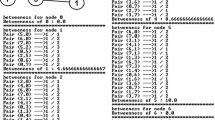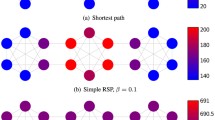Abstract
In wireless networks, the betweenness of a node has been considered an indication of that node’s importance in efficiently and reliably delivering messages. In a large wireless network, however, the cost of computing the betweenness of every node is impractically high. In this paper, we introduce a new representation of a node’s vicinity, called the expanded ego network (shortly, x-ego network) of that node. We also propose an approach that calculates the x-ego betweenness of a node (i.e., the betweenness of that node in its x-ego network) and use it as an estimate of the true betweenness in the entire network. Furthermore, we develop an algorithm that quickly computes x-ego betweenness by exploiting structural properties of x-ego networks. Our evaluation results show the benefits and effectiveness of the above approach using trace data obtained from real-world wireless networks.








Similar content being viewed by others
Notes
We use the term node and social link to refer to the devices and their relationships in a wireless network. On the other hand, the graph representing a wireless network consists of vertices and edges representing nodes and social links, respectively.
In \(\mathcal {X}_{{v}}\), all vertices including n are at most 2 hops away from v. n≠v cannot be a 2-hop neighbor of v since it is a 1-hop neighbor of t, which is a 2-hop neighbor of v. Therefore, n can only be a 1-hop neighbor of v.
References
Zhang Y, Pan E, Song L, Saad M, Dawy Z, Han Z (2014) IEEE Trans Wirel Commun 14 (1):177
Schurgot MR, Comaniciu C, Jaffres-Runser K (2012) IEEE Commun Mag 50(7):155
Papadimitriou A, Katsaros D, Manolopoulos Y (2010) Next Generation Society. Technological and Legal Issues 26:411
Katsaros D, Dimokas N, Tassiulas L (2010) IEEE Netw 24(6):23
Freeman LC (1979) Social Networks 1:215
Jain A, Reddy BVR (2013) In: Proc. of 2013 IEEE 3rd International Advance Computing Conference (IACC), pp 127– 131
Daly EM, Haahr M (2009) IEEE Trans Mobile Comput 8(5):606
Hui P, Crowcroft J, Yoneki E (2008) In: IEEE Trans. Mobile Comput., vol 10, pp 1576–1589
Dimokas N, Katsaros D, Manolopoulos Y (2007) In: Proc. of the 3rd International Conference on Mobile Multimedia Communications, MobiMedia 2007, pp 377–382
Cuzzocreaa A, Papadimitrioub A, Katsarosc D, Manolopoulosb Y (2012) J Netw Comput Appl 35 (4):1210
Gupta I, Riordan D, Sampalli S (2005) In: 3rd Annual Conference on Communication Networks and Services Research (CNSR 2005), pp 255–260
Marsden PV (2002) In: Social Networks, vol 24, pp 407–422
Everett M, Borgatti SP (2005) Soc Networks 27(1):31
Nanda S, Kotz D (2008) In: Proc of IEEE ICCN
Pantazopoulos P, Karaliopoulos M, Stavrakakis I (2013) In: 7th Int’l Workshop on Self-Organizing Systems (IFIP IWSOS’13)
Scott J, Gass R, Crowcroft J, Hui P, Diot C, Chaintreau A (2009) CRAWDAD data set cambridge/haggle (v. 2009-05-29). downloaded from http://crawdad.cs.dartmouth.edu/cambridge/haggle
Burgess J, Gallagher B, Jensen D, Levine B (2006) In: Proceedings of 25th IEEE INFOCOM, pp 1–11
Dubois-ferriere H, Grossglauser M, Vetterli M (2003) In: Proceedings of ACM MobiHoc, pp 257–266
Brandes U (2001) Journal of Mathematical Sociology 25:163
Tang L, Liu H (2010) Synthesis Lectures on Data Mining and Knowledge Discovery 2(1)
A list of papers that use CRAWDAD data and tools. http://www.citeulike.org/group/5303/library
Acknowledgements
This work has been supported by the National Science Foundation under CAREER award IIS-1149372, and also supported by Basic Science Research Program through the National Research Foundation (NRF) of Korea (No. NRF-2013R1A1A2010050).
Author information
Authors and Affiliations
Corresponding author
Rights and permissions
About this article
Cite this article
Kim, CM., Kim, Yh., Han, YH. et al. Efficient Estimation of Betweenness Centrality in Wireless Networks. Mobile Netw Appl 21, 469–481 (2016). https://doi.org/10.1007/s11036-015-0660-x
Published:
Issue Date:
DOI: https://doi.org/10.1007/s11036-015-0660-x




